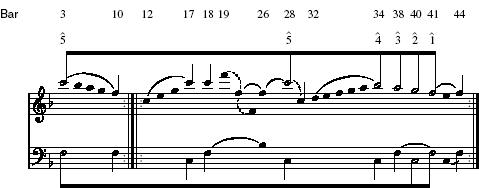2 Analysing the form of the Minuet and Trio
I now want to expand the graph of the trio section of the Minuet and Trio by looking at the form of the whole movement.
Activity 7
Listen twice to the whole of the Minuet and Trio (by clicking the player below), the first time with the full score and the second time with the piano score.
Click to open the full score of Beethoven's Eighth Symphony, third movement [Tip: hold Ctrl and click a link to open it in a new tab. (Hide tip)] .
Click to open the piano score.
Print out the piano score and at the minuet section, mark the following:
-
the most prominent note of the tonic triad in the melody line at the opening of the section;
-
the secondary keys to which the music modulates;
-
the most decisive cadence at the end of the section.
Answer
Discussion
-
Since the minuet begins with an arpeggio in the melody line through the whole tonic triad (bars 1–3), you might have chosen any of the three possibilities as the primary tone! But the A and the C seem the most likely, since the A arrives at the note at the top of the first tonic chord (bars 1–2), and the C is the note that begins the melody proper in bar 3. In fact, it is the C which is most prominent melodically, as the melody winds down from C in bar 3 to C an octave lower in bar 6, and then from the high C in bar 7 down to the tonic F at the double bar line in bar 10.
-
After the double bar, there are two modulations, first to C major (bars 11–16) and then B♭major (bars 17–26) before the return to F major from bar 27 onwards. There is a memorable harmonic progression through both C major and B♭major at bars 32–5.
-
The most decisive cadence is harder to identify; from bar 36, there is a constant alternation between dominant and tonic chords. You may have picked either the first cadence (bar 36), or the last one (bar 44), or the point where the horns stop emphasising the cadences in bars 40–1. Clearly we need to look at these bars in more detail.
In order to take account of the features you have just been thinking about, we need to develop a view of how the whole movement fits together. My view of this is again presented using video.
Activity 8
Watch the video below which builds up a complete background graph of the minuet section of the Minuet and Trio. Because the minuet is almost twice as long as the trio, this is not done in quite such painstaking, step-by-step detail as in the last video. Instead, I shall ask you to look at my analysis of the section, and see what you think of it when it is compared with the music.
Activity 9
Listen to the minuet again and follow the analysis in my final graph from the video band you have just watched (Example 9below).

Answer
Discussion
You should by now understand the sorts of decisions I made in order to analyse the form of this movement. Whether or not you agree with my decisions (which are my musical opinion), I hope you can see how I have tried to explain the sense of coherence and logic that Beethoven's music gives me when I listen.
